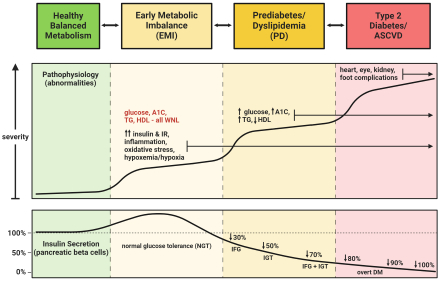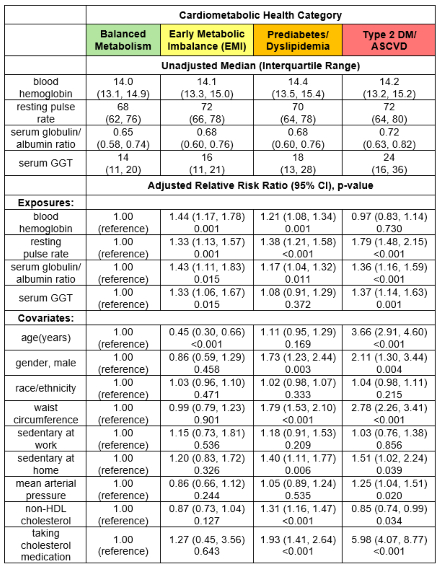Final ID: P1153
Hypoxia Response Markers are Associated with Early Metabolic Imbalance: The U.S. National Health and Nutrition Examination Survey
Abstract Body:
Introduction: The metabolism spectrum considers cardiometabolic health & disease as a series of four distinct categories, with progressing onset and severity of the underlying pathophysiology (Fig. 1). While prediabetes and metabolic syndrome are widely recognized categories, early metabolic imbalance (EMI) has largely been overlooked. Prevalent in teens and young adults, EMI is characterized by compensated insulin resistance, where fasting glucose, triglycerides, HDL cholesterol (HDL), and hemoglobin A1c are all within normal limits. Thus, EMI does not meet the criteria for prediabetes or metabolic syndrome and eludes risk screening for type 2 diabetes and ASCVD. In EMI, high circulating insulin overproduces nitric oxide, possibly leading to oxidized hemoglobin and a subclinical impairment of oxygen delivery to cells and tissues. Here, we investigated the association of hypoxia response markers with EMI in the U.S. population.
Hypothesis: Individuals with EMI show a compensatory response suggestive of subclinical hypoxia.
Methods: The fasting subsample from the 2015-2018 U.S. National Health & Nutrition Examination Survey was analyzed: 6,227 observations representing 270.2 million people in the U.S. ages 12 and up. Population-weighted multinomial logistic regression was performed using Stata v18.5. The outcome variable was cardiometabolic health, categorized into 1 of 4 groups: healthy balanced metabolism, EMI, prediabetes/dyslipidemia (PD), or type 2 diabetes/ASCVD (Fig. 1). EMI was defined using prognostic insulin cutpoints derived from timeROC analysis of the CARDIA cohort. The 1° exposure was blood hemoglobin concentration. Resting pulse rate, serum globulin/albumin ratio (chronic inflammation), and serum GGT (cell damage) were 2° exposures. The adjusted covariates are listed in Table 1. To quantify association, the effect size was relative risk ratio with 95% confidence interval and p-value.
Results: After adjusting for covariates, markers of the hypoxia response (hemoglobin, resting pulse rate, globulin/albumin ratio, GGT) were elevated in EMI compared with healthy balanced metabolism (Table 1, bottom panel). These increases were not apparent from a simple inspection of the unadjusted median values (top panel).
Conclusion: EMI includes an insidious compensatory response to hypoxia. This observation is consistent with prior observations that dysfunctional hemoglobin is coupled to poor metabolic health. Further investigation is warranted.
Introduction: The metabolism spectrum considers cardiometabolic health & disease as a series of four distinct categories, with progressing onset and severity of the underlying pathophysiology (Fig. 1). While prediabetes and metabolic syndrome are widely recognized categories, early metabolic imbalance (EMI) has largely been overlooked. Prevalent in teens and young adults, EMI is characterized by compensated insulin resistance, where fasting glucose, triglycerides, HDL cholesterol (HDL), and hemoglobin A1c are all within normal limits. Thus, EMI does not meet the criteria for prediabetes or metabolic syndrome and eludes risk screening for type 2 diabetes and ASCVD. In EMI, high circulating insulin overproduces nitric oxide, possibly leading to oxidized hemoglobin and a subclinical impairment of oxygen delivery to cells and tissues. Here, we investigated the association of hypoxia response markers with EMI in the U.S. population.
Hypothesis: Individuals with EMI show a compensatory response suggestive of subclinical hypoxia.
Methods: The fasting subsample from the 2015-2018 U.S. National Health & Nutrition Examination Survey was analyzed: 6,227 observations representing 270.2 million people in the U.S. ages 12 and up. Population-weighted multinomial logistic regression was performed using Stata v18.5. The outcome variable was cardiometabolic health, categorized into 1 of 4 groups: healthy balanced metabolism, EMI, prediabetes/dyslipidemia (PD), or type 2 diabetes/ASCVD (Fig. 1). EMI was defined using prognostic insulin cutpoints derived from timeROC analysis of the CARDIA cohort. The 1° exposure was blood hemoglobin concentration. Resting pulse rate, serum globulin/albumin ratio (chronic inflammation), and serum GGT (cell damage) were 2° exposures. The adjusted covariates are listed in Table 1. To quantify association, the effect size was relative risk ratio with 95% confidence interval and p-value.
Results: After adjusting for covariates, markers of the hypoxia response (hemoglobin, resting pulse rate, globulin/albumin ratio, GGT) were elevated in EMI compared with healthy balanced metabolism (Table 1, bottom panel). These increases were not apparent from a simple inspection of the unadjusted median values (top panel).
Conclusion: EMI includes an insidious compensatory response to hypoxia. This observation is consistent with prior observations that dysfunctional hemoglobin is coupled to poor metabolic health. Further investigation is warranted.
More abstracts on this topic:
A recombinant protein oxygen carrier with reduced nitric oxide scavenging as a blood substitute for resuscitation
Xu Qinzi, Rochon Elizabeth, Bocian Kaitlin, Huang Xue, Poropatich Ronald, Gladwin Mark, Tejero Jesus, Rose Jason, Rodriguez Deborah, Hwang Hyon, Turner Bryan, Hunt Thomas, Dent Matthew, Demartino Anthony, Abdelghany Youmna, Chen Xiukai
Association of Hemoglobin and Partial Pressure of Oxygen in Arterial Blood on Survival and Neurologic Outcomes in In-Hospital Cardiac Arrest PatientsKoul Rudra, Gupta Vasu, Qadeer Nasheeta, Patel Jignesh


